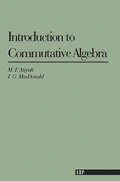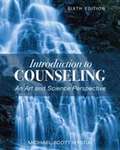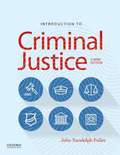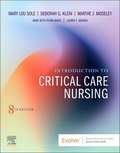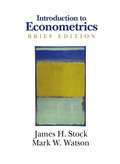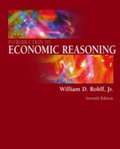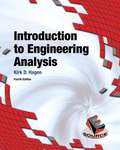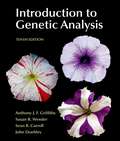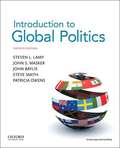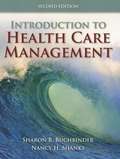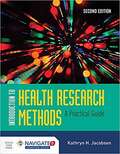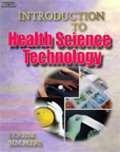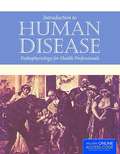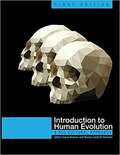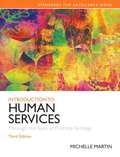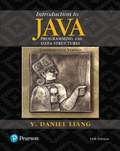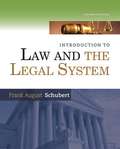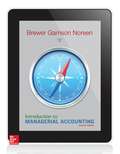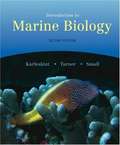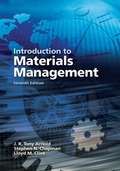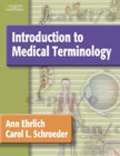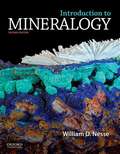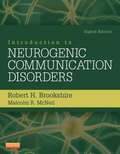- Table View
- List View
Introduction To Commutative Algebra
by Michael Atiyah I. G. MacdonaldThis book grew out of a course of lectures given to third year undergraduates at Oxford University and it has the modest aim of producing a rapid introduction to the subject. It is designed to be read by students who have had a first elementary course in general algebra. On the other hand, it is not intended as a substitute for the more voluminous tracts such as Zariski-Samuel or Bourbaki. We have concentrated on certain central topics, and large areas, such as field theory, are not touched. In content we cover rather more ground than Northcott and our treatment is substantially different in that, following the modern trend, we put more emphasis on modules and localization.
Introduction To Counseling: An Art And Science Perspective
by Michael NystulIntroduction to Counseling: An Art and Science Perspective provides students with an accessible overview of the counseling profession and also demonstrates how fundamental counseling concepts can be employed to successfully address everyday life challenges. The book posits that counseling is both an art and a science, highlighting the balance between the subjective and objective dimensions of counseling. <p><p> The first part of the book offers students an introduction to the counseling profession and the counseling process, introducing them to conceptual models for counseling, legal and ethical issues, and assessment, research, and evaluation. The second part of the text provides information on multicultural counseling and counseling theories, emphasizing models that are inclusive and adaptive. The final part of the text identifies special approaches and modalities that are helpful in the treatment of diverse populations in particular settings, including children and adolescents in school settings, individuals with mental health issues in hospitals, clinics, and private practices, and more. <p> The sixth edition of Introduction to Counseling features increased focus on professional identity of counselors, content on wellness and positive psychology, increased focus and awareness of social justice issues and advocacy as important dimensions of multicultural counseling, new information on technology-assisted methods of counseling, increased focus on the role of neuroscience in counseling, updated information on the changes in ethical codes, and new guidelines for diagnosis in DSM-5. Presenting timely and critical information in an approachable way, the text is a valuable resource for undergraduate and graduate-level students pursuing helping professions.
Introduction To Criminal Justice: A Brief Edition
by John Randolph FullerIntroduction to Criminal Justice: A Brief Edition provides students with coverage of core concepts supported by student-tested pedagogical tools that promote student engagement, thought-provoking classroom discussions, and critical-thinking skills.
Introduction To Critical Care Nursing
by Mary Lou Sole Deborah Goldenberg Klein Marthe J. MoseleyStart here to master the concepts, technology, and procedures of critical care nursing! Introduction to Critical Care Nursing, 8th Edition prepares you to provide safe, effective, patient-centered care in a variety of high-acuity, progressive, and critical care settings. Evidence-based coverage includes realistic case studies and incorporates the latest advances in critical care. Disorders are conveniently organized by body system or special situation, and nursing management chapters include quick-reference nursing care plans. This clear, concise textbook will help you develop the knowledge and clinical reasoning skills needed for success in today's highly complex critical care environments.
Introduction To Econometrics (Brief Edition)
by James H. Stock Mark W. WatsonIn keeping with their successful introductory econometrics text, Stock and Watson motivate each methodological topic with a real-world policy application that uses data, so that readers apply the theory immediately. Introduction to Econometrics, Brief, is a streamlined version of their text, including the fundamental topics, an early review of statistics and probability, the core material of regression with cross-sectional data, and a capstone chapter on conducting empirical analysis. Introduction and Review: Economic Questions and Data; Review of Probability; Review of Statistics. Fundamentals of Regression Analysis: Linear Regression with One Regressor; Regression with a Single Regressor: Hypothesis Tests and Confidence Intervals in the Single-Regressor Model; Linear Regression with Multiple Regressors; Hypothesis Tests and Confidence Intervals in the Multiple Regressor Model; Nonlinear Regression Functions; Assessing Studies Based on Multiple Regression; Conducting a Regression Study Using Economic Data. MARKET: For all readers interested in econometrics.
Introduction To Economic Reasoning
by William D. RohlfWith a goal of encouraging students to become informed decision-makers, Introduction to Economic Reasoning, Seventh Edition, provides a non-technical, concise introduction to basic economic theories that is ideal for a one-semester course. The Seventh Edition relates coherent explanations of general theories and models with thought-provoking, current features that apply and enliven core concepts. The hands-on economic reasoning approach promotes the idea that students can use economic analysis in their everyday lives to help them succeed in their careers and understand today's global economic issues.
Introduction To Engineering Analysis
by Kirk HagenFor use in the first-year engineering course. This text is also suitable for individuals interested in adopting a problem-solving approach to engineering problems. <P><P> The goal of this text is to introduce a general problem-solving approach for the beginning engineering student. Thus, Introduction to Engineering Analysis focuses on how to solve (any) kind of engineering analytical problem in a logical and systematic way. The book helps to prepare the students for such analytically oriented courses as statics, strength of materials, electrical circuits, fluid mechanics, thermodynamics, etc.
Introduction To Genetic Analysis
by Sean B. Carroll Anthony J. F. Griffiths Susan R. Wessler John DoebleySince its inception, Introduction to Genetic Analysis has been known for its prominent authorship--leading scientists in their field who are great educators. This market best-seller exposes students to the landmark experiments in genetics, teaching students how to analyze experimental data and how to draw their own conclusions based on scientific thinking while teaching students how to think like geneticists.
Introduction To Global Politics (Fourth Edition)
by Steve Lamy John MaskerIntroduction to Global Politics, Fourth Edition, provides students with a current, engaging, and non-U.S. perspective on global politics. It shows students how to analyze global political events using theoretical approaches-both mainstream and alternative-and emphasizes non-state actors more than any other global politics text.
Introduction To Health Care Management
by Sharon B. Buchbinder Nancy H. ShanksIntroduction to Health Care Management is a concise, reader-friendly, introductory healthcare management book that covers a wide variety of healthcare settings, from hospitals to nursing homes and clinics. Filled with examples to engage the reader's imagination, the important issues in healthcare management, such as ethics, cost management, strategic planning and marketing, information technology, and human resources, are all thoroughly covered. Guidelines and rubrics along with numerous case studies make this text both student-friendly and teacher friendly. It is the perfect resource for students of healthcare management, nursing, allied health, business administration, pharmacy, occupational therapy, public administration, and public health. "Drs. Buchbinder and Shanks have done a masterful job in selecting topics and authors and putting them together in a meaningful and coherent manner. Each chapter of the book is designed to give the student the core content that must become part of the repertoire of each and every healthcare manager, whether entry level or senior executive. Each of the chapters and accompanying cases serve to bring to life what it means to be a truly competent healthcare manager.
Introduction To Health Research Methods
by Kathryn H. JacobsenThis clear, practical, and straightforward text demystifies the research process and empowers students and other new investigators to conduct their own original research projects. In five sections, Introduction to Health Research Methods describes the entire research process beginning with the identification of a research question and the selection of a study approach, proceeding through the collection and analysis of data and the preparation of a formal scientific report, and ending with academic and professional presentations and publishing. By breaking down the process into manageable steps, Introduction to Health Research Methods communicates the excitement and importance of health researchâ€"and encourages readers to make their own contribution to improving the health of individuals and communities through research. <P><P> The Second Edition is a thorough update that offers: - A new chapter on mentorship and other professional development opportunities - A new chapter on grant writing with sections on funding sources, finding grant opportunities, proposal writing, budgeting, and grant management - A new chapter introducing several analysis tools that move beyond standard biostatistical techniques such as GIS, mathematical modeling, and economic analysis - A comprehensive walk through of successful writing strategies with dozens of ideas for how to get started on writing and stay motivated - New information on qualitative studies including interviewing, focus group discussions, coding and analysis, mixed methods research, and monitoring and evaluation
Introduction To Health Science Technology
by Louise SimmersIntroduction to Health Science Technology covers the core information needed to pursue a career in health care from an introduction of the health care industry and the basics of a health care system to overview of health care careers and legal and ethical responsibilities of health care workers to medical terminology and basic anatomy and physiology.
Introduction To Human Disease: Pathophysiology For Health Professionals, 6th Edition
by Agnes G. Loeffler Michael N. HartIntroduction to Human Disease: Pathophysiology for Health Professionals, Sixth Edition provides a broad overview of the most common and important human diseases for students pursuing careers in the health professions. Comprehensive yet accessible, it addresses the aspects of disease epidemiology, diagnosis, and treatment that are essential to clinical practice. The Sixth Edition of this popular text has been thoroughly updated to cover the latest advances in medical knowledge and practice, especially with regard to mental health and nutritional disorders. It also includes additional clinical information on treatments for diseases. Designed to facilitate learning, this essential reference features new full-color photos and illustrations, learning objectives, and practice questions for review and assessment. Introduction to Human Disease: Pathophysiology for Health Professions, Sixth Edition will help students gain a solid foundation in disease pathology and medical terminology to help them throughout their medical education. KEY FEATURES* Provides a comprehensive introduction to the essential aspects of human disease* Covers the most common and important human diseases, including mental illnesses* Facilitates learning with chapter objectives, key terms, and practice questions * Includes more than 400 full-color illustrations, photos, and tablesNEW TO THE SIXTH EDITION* New photos and illustrations* New and updated resources for instructors and students* Updated content reflects the current state of medical knowledge and practice* More clinical information, including general and specific treatments for diseases with an emphasize on common laboratory tests* Chapter 26: Infectious Diseases and Chapter 27: Immunologic Diseases are revised and now included in Section 4: Multiple Organ System Diseases* Chapters 24: Mental Illness and 30: Nutritional Disorders are revised, to bring them up-to-date with current health problems (e. g. obesity), concepts, and terminologies
Introduction To Human Evolution: A Bio-Cultural Approach
by Gillian Crane-Kramer Roman Gastrell Harrison"Introduction to Human Evolution has been developed in direct response to student feedback on the standard textbook approach to the subject matter. Concise and filled with engaging images, the book makes evolution, primatology, and human variation appealing to today's learners. <p><p> The book introduces readers to issues surrounding the theory of evolution, sheds light on questions about what evolution is or isn't, and discusses how we know what we think we do about it. <p><p> Readers will learn about early hominins, the Australopithecines, and the genus Homo. The book also addresses population history and genetics, adaptation and acclimatization, and anatomically modern humans. It concludes with the big question—where will we go from here? <p><p> Each chapter is a balance of text, exercises, graphs, and visuals. The exercise worksheets support independent learning, and answers are provided to allow for self-assessment. <p><p> Introduction to Human Evolution is an excellent choice for courses in anthropology and biology. It is accessible to non-majors, but can also be used in introductory courses for science majors. <p><p> Gillian Crane-Kramer earned her Ph.D. in archeology/biological anthropology from the University of Calgary, Canada. She is a professor in the Department of Anthropology at the State University of New York at Plattsburgh. Dr. Crane-Kramer is an Osteologist who specializes in the evolution of infectious disease through time. <p><p> Roman Harrison earned his Ph.D. in archaeology at the University of Calgary. Dr. Harrison is a lecturer in the Department of Sociology and Anthropology at Mount Royal University in Calgary, Alberta, and a member of the Canadian Association for Physical Anthropology.
Introduction To Human Services: Through The Eyes Of Practice Settings
by Michelle E. MartinProvides readers with an understanding of the Human Services Profession. Introduction to Human Services: Through the Eyes of Practice Settings, 3/e explores human services through the lens of the most common practice settings where human service professionals work. This title also provides information about social problems within a socio-political context allowing readers to think about ways in which culture and ideology influence people's perspectives. Standards for Excellence series -- Each chapter highlights the national standards set by the Council for Standards in Human Service Education (CSHSE). Critical thinking questions throughout reinforces this integration. Learning Goals Upon completing this book, readers will be able to: Understand the issues pertinent to human services from new perspectives. Challenge the status quo of human services. Recognize their own stereotypical thinking that may create barriers to becoming effective helpers.
Introduction To Information Security: A Strategic-based Approach
by Timothy Shimeall Jonathan SpringMost introductory texts provide a technology-based survey of methods and techniques that leaves the reader without a clear understanding of the interrelationships between methods and techniques. By providing a strategy-based introduction, the reader is given a clear understanding of how to provide overlapping defenses for critical information. This understanding provides a basis for engineering and risk-management decisions in the defense of information. Information security is a rapidly growing field, with a projected need for thousands of professionals within the next decade in the government sector alone. It is also a field that has changed in the last decade from a largely theory-based discipline to an experience-based discipline. This shift in the field has left several of the classic texts with a strongly dated feel.
Introduction To Java Programming And Data Structures: Comprehensive Version
by Y. Daniel LiangThis text is intended for a 1-semester CS1 course sequence. The Brief Version contains the first 18 chapters of the Comprehensive Version. The first 13 chapters are appropriate for preparing the AP Computer Science exam. Coverage of Java and programming make this a useful reference for beginning programmers and IT professionals. Daniel Liang teaches concepts of problem-solving and object-oriented programming using a fundamentals-first approach. Beginning programmers learn critical problem-solving techniques then move on to grasp the key concepts of object-oriented, GUI programming, advanced GUI and Web programming using Java. Liang approaches Java GUI programming using JavaFX, not only because JavaFX is much simpler for new Java programmers to learn and use but because it has replaced Swing as the new GUI tool for developing cross-platform-rich Internet applications on desktop computers, on hand-held devices, and on the Web. Additionally, for instructors, JavaFXprovides a better teaching tool for demonstrating object-oriented programming.
Introduction To Law And The Legal System
by Frank August SchubertINTRODUCTION TO LAW AND THE LEGAL SYSTEM provides an overview of law and the American legal system, using cases to support the major functions of U. S. law. Suitable for a variety of departments and courses, this text is known for its broad coverage, flexible organization, and use of cases to explain legal concepts.
Introduction To Livestock & Companion Animals (Third edition)
by Jasper S. LeeIntroduction to Livestock and Companion Animals has been revised to serve as an introductory textbook in animal science and veterinary technology. It is about far more than cattle, swine, and chickens, though these are included. It integrates a multitude of perspectives on animal education.
Introduction To Managerial Accounting 7th Edition
by Eric W. Noreen Ray H. Garrison Peter C. BrewerIntroduction to Managerial Accounting, 7/e by Brewer/Garrison/Noreen is based on the market-leading text, Managerial Accounting, by Garrison, Noreen and Brewer. The 7e is a briefer, more accessible, and thoroughly student-friendly text that satisfies the basic needs of the managerial accounting student without unnecessary depth on advanced topics associated with the follow-up course cost accounting/cost management. Faculty and students alike will find this new edition has retained the hallmark features of the Garrison brand: author-written supplements, excellent readability, terrific examples, and balanced end-of-chapter material.
Introduction To Marine Biology
by George Karleskint James W. Small Richard TurnerThis undergraduate textbook explores the ways in which marine organisms interact with each other and with their physical environment, and explains the importance of marine ecosystems to terrestrial ecosystems and to humankind. Hundreds of color photographs are provided. The second edition adds sections on population dynamics, marine viruses, and coral diseases. Annotation ©2004 Book News, Inc., Portland, OR (booknews.com)
Introduction To Materials Management
by J. R. Tony Arnold Stephen N. Chapman Lloyd M. CliveIntroduction to Materials Management, Seventh Edition covers all the essentials of modern supply chain management, manufacturing planning and control systems, purchasing, and physical distribution. Clearly written and exceptionally user-friendly, its content, examples, questions, and problems lead students step-by-step to mastery. This edition’s extensive updates include: new techniques, technology, and case studies; reorganized and expanded coverage of lean production and JIT manufacturing; new information on sustainability and “green” production; use of INCOTERMS for global supply chains; revised end-of-chapter problems, and more. Widely adopted by colleges and universities worldwide, this is the only APICS-listed reference text for the Basics of Supply Chain Management (BSCM) CPIM certification examination.
Introduction To Medical Terminology
by Ann Ehrlich Carol L. Schroeder Ann Roe-HaferThis undergraduate textbook describes the structure and function of the 12 systems that make up the human body, defines each system's pathology, and overviews the primary diagnostic and treatment procedures performed. Color illustrations are provided. The CD- ROM contains exercises and games. Annotation (c)2003 Book News, Inc. , Portland, OR (booknews. com)
Introduction To Mineralogy
by William NesseThe second edition of Introduction to Mineralogy follows the highly successful first edition, which become an overnight market leader. Introduction to Mineralogy consolidates much of the material now covered in traditional mineralogy and optical mineralogy courses and focuses on describing minerals within their geologic context. It presents the important traditional content of mineralogy including crystallography, chemical bonding, controls on mineral structure, mineral stability, and crystal growth to provide a foundation that enables students to understand the nature and occurrence of minerals. Physical, optical, and X-ray powder diffraction techniques of mineral study are described in detail, and common chemical analytical methods are outlined as well. Detailed descriptions of over 100 common minerals are provided, and the geologic context within which these minerals occur is emphasized. Appendices provide tables and diagrams to help students with mineral identification, using both physical and optical properties. Numerous line drawings, photographs, and photomicrographs help make complex concepts understandable. Introduction to Mineralogy is available with Daniel Schulze's An Atlas of Minerals in Thin Section for a nominal additional fee. NEW TO THIS EDITION: -New 2-color design to clarify information hierarchy and presentation -Expanded selection of mineral photos -Improved presentation of physical properties of minerals in chapter 1 -Updated mineral descriptions -New coverage of minerals and health
Introduction To Neurogenic Communication Disorders
by Robert H. Brookshire Malcolm R. McNeilGet the tools you need to evaluate, diagnose, and treat patients with neurogenic communication disorders! Introduction to Neurogenic Communication Disorders, 8th Edition provides a solid foundation in the neurology of communication, as well as the causes, symptoms, diagnosis, assessment, and management of commonly encountered neurogenic communication disorders in adults. A concise, evidence-based approach shows how to measure and treat abnormalities such as aphasia, dysarthria, right-hemisphere syndrome, and traumatic brain injury syndrome. <P><P>This edition is updated with new coverage of laboratory tests, blast-related injuries to the head, and medications for dementia. Created by neurogenic communication disorders educator Robert H. Brookshire and continued by Malcolm R. McNeil, this bestselling text will enhance your skills in the rehabilitation of clients with neurogenic communication disorders.
